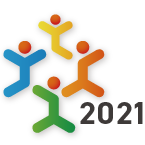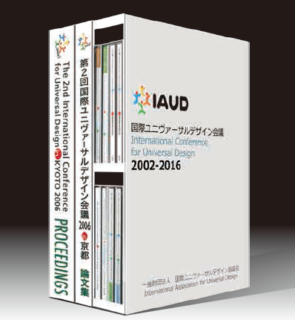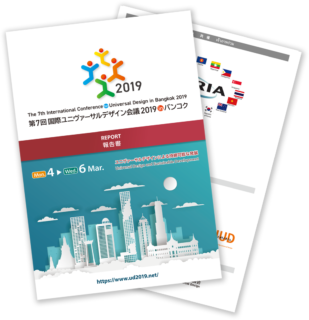2025.05.29
towards2010: From Kyoto to Hamamatsu: reflections on UD 2/3
2010.05.24 Updated
Recent reading
Two books that make this case in their own very different ways have been my companions for the past few months. I have been reading them slowly, dipping in, moving between one and the other and rereading on a regular basis. One is a classic text from the past – Design for the Real World (ref. 4) by Victor Papanek – the other is Design meets Disability by Graham Pullin (ref. 5). Papanek held very strong views that did not endear him to the design establishment of his times, and left him somewhat saddened in later life. I remember speaking with him in Amsterdam and later in London, in 1997, where I dined with him in the evening and we talked about the challenges facing design and humanity – and it is a pity that he did not live to see the changes that are now taking place in design and appreciate the uptake of his ideas by a younger generation that is less interested in ‘signature’ design and more concerned about the future of the planet. In Design for the Real World he rails against consumerism, and attacks designers for pandering to it. Much of this tirade may seem dated and in some respects suspect, given the amount of change we have seen since the early 70s, but at the heart of the book is a powerful case for design at the service of real needs and in particular the needs of those who are less fortunate. In the book he introduces the idea of ‘responsible design,’ which Roger Whitehouse picked up on in his keynote and advocates a programme for implementation that would sit well with the collective aspirations expressed at the Kyoto conference.
Graham Pullin starts at two points, high design and disability and explores a speculative meeting of the two. Propelling his thinking is, on the one hand, the question: ‘why cannot we see the same design sensibility applied to hearing aids and other assistive products that has been so successfully applied to glasses?’ – making them a ‘must have’ fashion accessory and opening up a market to fund the level of technological development that currently offers so many people first class vision. On the other hand he believes mainstream design has much to learn from disabled people and sees disability as a great driver for innovation, as a potentially inspiring influence on design, rather than a brake. He explores this through real, fictional and analytic meetings – when the Eamses met leg splints (real); when universal meets simple (analytic); and if Philippe Starke met bottom wipers (fictional). What he is advocating is the application of blue-skies, high design thinking to the sort of challenges identified by Victor Papanek, with disabled people as co-designers and experts in living with and innovating in order to live with those real life challenges. Not a million miles away from the approach adopted at the Helen Hamlyn Centre through its Inclusive Design Challenges, where young professional designers are paired with disabled users, and its Research Associate Programme where blue-skies thinking is applied to real life challenges in collaboration with major companies and charities. The Inclusive Design Challenge model has been exported around the world and is featured in the Kyoto Keynotes, and again, it is such a pity that Victor Papanek could not be there in Kyoto with us. Like Graham we can only speculate on that meeting. But I would recommend both books to anyone planning to attend the next IAUD conference in Hammamamtsu in 2010, for both are challenging us to ‘up our game’ and make Universal Design a dominant force in the 21st century.
Transnational collaboration
I see this becoming a reality in the Nordic countries – Denmark, Sweden, Norway and Finland – where there is growing transnational collaboration in the fields of welfare, design and research. In one sense this is not surprising as the social welfare model is closely associated with Scandinavia, and the region also has a strong tradition of functional design. These two tendencies came together in an influential way at the Konstfack University College of Arts Crafts and Design in Stockholm in the summer of 1968 when Victor Papanek spoke at a pardigm-shifting orkshop, and the international disability symbol of a figure in a wheelchair was originally developed (ref. 6). What is interesting in the Nordic countries is the way in which people have organised politically and the strong links between design, education and political developments, not just within countries, but across the region. Lars Lindberg, in his Keynote UD in Northern Europe, spoke about this very much through the lens of legislation and government initiatives, whereas Dag Klingstedt of Ergonomidesign spoke through the lens of design in his Keynote UD for Daily Commodities. He concentrated on the evolution of design at Ergonomi, where the user-research methods first applied by Maria Benktzon and Sven-Eric Juhlin to developing assistive products were later applied to mainstream products such as hand tools and baby carriers.
But there is a bigger story that links the two keynotes, and that is one of progress through transnational initiatives such as the Nordic Council on Disability and the Nordic Welfare Centre that have placed a strong emphasis on delivering an inclusive society through design and education. Initiatives around ‘The Modern Journey’, ‘Tourism for All’ and City Planning for All have led directly to fine exemplars like the Copenhagen Metro and Elephant House, cited above, and to a growing recognition by business of not just the Corporate Social Responsibility potential of Universal Design, but also its potential for business development and innovation. Most importantly perhaps has been the sharing and transfer of knowledge around the region, with competencies developed in specific countries, such as the product innovation and user-research processes pioneered by Ergonomidesign, being generalised across the region. This in turn has given added momentum to the Design for All movement in the Nordic countries and these achievements have been well represented and promulgated through Form & Function, the Nordic Design for All magazine. What we see from this transnational collaboration is a proliferation of high quality design delivering benefits for the whole population, across the life-span, rather than a focus on individual solutions, in the form of costly and often poorly designed and made assistive products, that are still, unfortunately, the norm elsewhere.
Knowledge transfer
Knowledge transfer is a key issue here, as is the research base for our activities. I talked earlier about the importance of an evidence-base for good design, and I think this is crucial, not just to ensure the value and validity of design solutions, but also to bring industry on side. In the UK we have benefited from research funding through the Engineering and Physical Sciences Research Council (EPSRC), and this funding has acted as a springboard for the British Standard in Inclusive Design Management, which in turn has led to a number of collaborations with industry, most notable of which is the BT transformation programme. John Clarkson covered some of this ground in his two keynotes on Countering Design Exclusion and The practicalities of Inclusive Design, and he and I have gone on in the UK to establish what we hope is the beginning of an Inclusive Design Journal by special issue. By that I mean not a dedicated journal in the subject area, which we both felt would be counterproductive and serve to isolate rather than integrate UD. Instead we have negotiated the production of special inclusive design issues of established mainstream journals and hope to repeat and expand this initiative in the future.
By the time we all gather in Hamamatsu there should be two special issues of the Journal of Engineering Design and one of Applied Ergonomics in publication. This initiative, allied to the HHC Inclusive Design Challenges, the Research Associates Programme of industry collaborations and the PhD programme at the Engineering Design Centre in Cambridge, led by John Clarkson, will, we hope, serve to inspire a new generation of designers and researchers and ensure the continuing transfer of knowledge from research and education to industry. It is my personal belief that this focus on the next generation will be crucial to the future success of UD. An important reason for this is the growing pace of technological development and product and service innovation that feeds off it. So much of our work in the past has been driven by the inadequacies of the designed world, and the lack of ‘fit’ between mainstream products and services and the population as a whole and over our growing lifespans. The future challenge is to move beyond this reactive phase of UD to a new ear of innovation through UD.
Repeating the past
In the context of an increasingly global consumer society it is ironic that so much effort has to go into correcting the mistakes of the past, but we are increasingly vulnerable to ‘design exclusion’ as John Clarkson stressed in his keynote, in particular in the field of communications and new media. As companies target younger people and pay scant or no attention to the needs of older and disabled people, so we face growing design exclusion in the very fields where the technology is readily available not simply to counter design exclusion, but to usher in a new era of universal access. Barrier-free design has, over the years, significantly eroded design exclusion in the built environment, and the examples I have cited above give us a very clear and optimistic vision of future built on UD principles. The Web Accessibility Consortium (W3C) has made similar progress with regard to the internet, and disability / accessibility legislation in several countries is reinforcing theses gains and extending them, in particular, to public and consumer services.
However, progress in product design is slower, in part because it is far harder to regulate and legislate for, in part because international standards are lagging behind legislation, and in part because of the increasing pace of new product development and introduction which imposes time and cost pressure on the product development process to the detriment of user testing and evaluation. While we can see incremental progress in, for example, vehicles and consumer durables, mistakes are constantly repeated in those sectors where smaller companies are dominant. While we are building a knowledge base of tools, user-research techniques and capability data that is gradually being adopted by larger companies – described by John Clarkson in his keynotes, and due to feature in the special issue of Applied Ergonomics in 2010 – rapid advances in personal communications products make this sector particularly vulnerable to built-in design exclusion, in particular as early adopters are primarily younger and more able users. Nokia has made a significant commitment to adopting a UD approach, and has worked closely with the HHC on a series of projects and workshops, but what is vitally needed in this field is a collection of inspirational design exemplars to drive innovation in a UD direction without compromising consumer appeal.
For some years now the HHC has taken up this challenge through its Research Associates Programme, and although many of the resulting designs have only ever reached concept stage – inevitable in the context of a one-year exploratory collaboration between design, research and industry – they have served to help companies think ahead and anticipate future applications of technology that enable rather than disable (ref. 7). There is now a significant collection of these design exemplars, all of which can be accessed initially via the HHC website. The quality varies, and again this is inevitable in a collection of student projects, but the collection as a whole now constitutes a valuable resource, and individual projects can be followed up through RCA Research Fellow Rama Gheerawo who leads the RA programme at the HHC. A group of four projects from 2008/9 is relevant here. Two, with partners Blackberry and Samsung deal with populations excluded by age or ability. The key ideas are: first, tackle the manual by building an analogue bridge across the digital divide, and second, ‘eyes-free’ operation can offer benefits to everyone and complement 'hands-free' operation. The other two look at sustainable (environmental and social) technology – focusing on electric cars and rural India. The key ideas are: first, can digital technologies better connect the car to its driver in ways that are also beneficial to the city environment, and second, access to energy lifts people out of poverty, if the Indian government gave every home electricity, how could it best be used? These projects can be accessed at (www.hhc.rca.ac.uk/1652/all/1/inclusive_design.aspx) and a full list of relevant past projects is given in the references section.
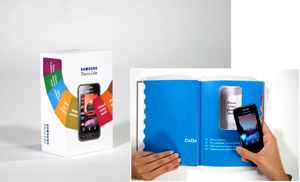 |
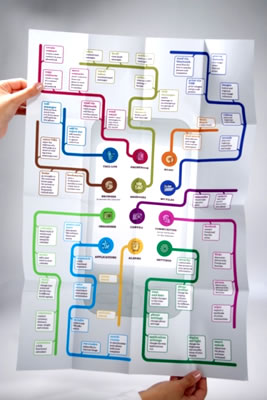 |
External packaging & Manual integrated with phone to reveal functions and operation |
|
 |
|
Instruction / shortcut cards for phone functions |
Complete interface / function map |





